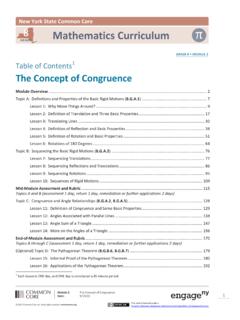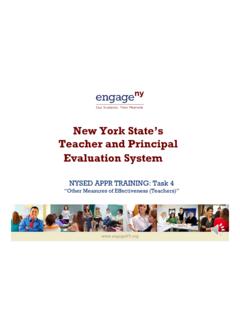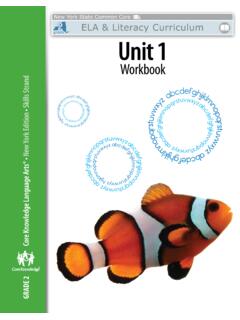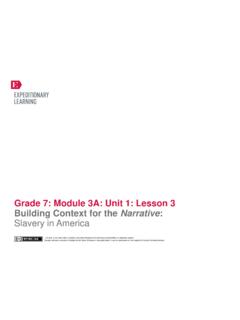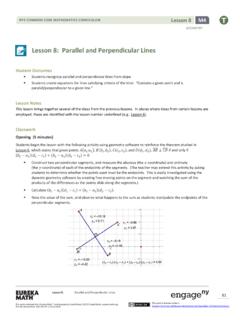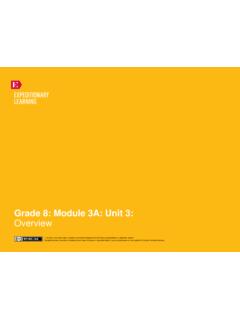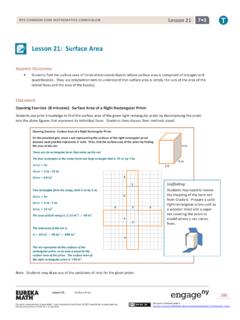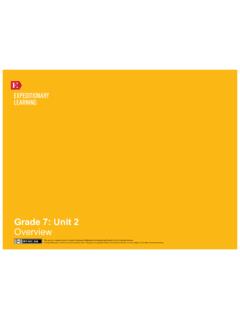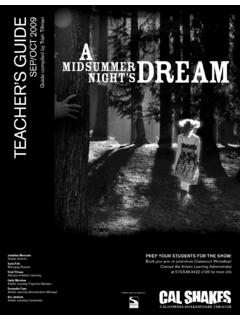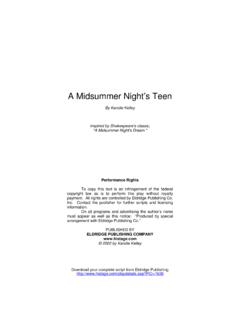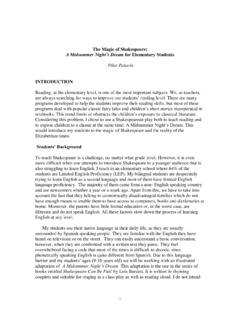Transcription of Grade 8 Curriculum Map - EngageNY
1 This work is licensed under a Creative Commons Attribution-NonCommercial-ShareAlike Unported License. Exempt third-party content is indicated by the footer: (name of copyright holder). Used by permission and not subject to Creative Commons license. Grade 8 Curriculum Map Grade 8 NYS Common Core Aligned Curriculum Map 2013 Expeditionary Learning, New York, NY. All Rights Reserved. NYS Common Core ELA Curriculum G8: Curriculum Map Updated November 2013 1 These grades 6 8 Curriculum modules are designed to address CCSS ELA outcomes during a 45-minute English Language Arts block. The overarching focus for all modules is on building students literacy skills as they develop knowledge about the world.
2 Taken as a whole, these modules are designed to give teachers concrete strategies to address the instructional shifts required by the CCLS. Structure of a Module Each module provides eight weeks of instruction, broken into three shorter units. Each module includes seven assessments: Six unit-level assessments that almost always are on-demand: students independent work on a reading, writing, speaking, or listening task. One final performance task that is a more supported project, often involving research. Structure of a Year of Instruction There are six modules per Grade level. Of these six modules, teachers would teach four: Module 1, followed by either Module 2A or 2B, then either 3A or 3B, then Module 4.
3 Teachers should begin the year with Module 1, which lays the foundation for both teachers and students regarding instructional routines. For Modules 2 and 3, option B formally assesses all standards formally assessed in Option A (and possibly some additional standards as well). How to Read This Document The purpose of this document is to provide a high-level summary of each module and name the standards formally assessed in each module. Module focus: Read this first. The focus is the same across the grades 3-5 band and signals the progression of literacy skills across the year as well as alignment to the CCSS instructional shifts.
4 Module title: This signals the topic students will be learning about (often connected to social studies or science) and aligns with Instructional Shift #2, building knowledge in the disciplines. Description: These three or four sentences tell the basic story of the eight-week arc of instruction: the literacy skills, content knowledge, and central text. Texts: This lists texts that all students read. The text in bold is the extended text for a given module: the text(s) with which students spend the most time. Remember that texts can be complex based on both qualitative and quantitative measures. Texts are listed in order from most quantitatively complex (based on Lexile measure) to Grade 8 NYS Common Core Aligned Curriculum Map 2013 Expeditionary Learning, New York, NY.
5 All Rights Reserved. NYS Common Core ELA Curriculum G8: Curriculum Map Updated November 2013 2 least quantitatively complex. Texts near the bottom of the list are often complex in ways other than Lexile. Within a given module, the list shows the wide variety of texts students read as they build knowledge about a topic. This aligns with Instructional Shift #2, building knowledge in the disciplines. Final Performance Task: This is a culminating project, which takes place during Unit 3 of every module. Performance tasks are designed to help students synthesize and apply their learning from the module in an engaging and authentic way.
6 Performance tasks are developed using the writing process, are scaffolded, and almost always include peer critique and revision. Performance tasks are not on-demand assessments. (Note: The end of Unit 3 assessment often addresses key components of the performance task.) Unit-Level Assessments Each unit includes two assessments, most of which are on-demand ( , show what you know/can do on your own). Mid-unit assessments typically, though not always, are reading assessments: text-based answers. End of unit assessments typically, though not always, are writing assessments: writing from sources. Most assessments have a heavy emphasis on academic vocabulary, particularly determining words in context.
7 Assessments are designed to be Curriculum -embedded opportunities to practice the types of skills needed on the NYS assessment. The Curriculum map below lists the title of each assessment, the standards assessed, and the assessment format. Selected response (multiple-choice questions) Short constructed-response (short-answer questions of the type that is scored using the NYS 2-point rubric) Extended response (longer writing or essays of the type that is scored using the NYS 4-point rubric) (either on-demand or supported) Speaking and listening (discussion or oral presentation) Scaffolded essay (involving planning, drafting, and revision) Standards: In each module, the standards formally assessed are indicated with a check mark; see details below.
8 Grade 8 NYS Common Core Aligned Curriculum Map 2013 Expeditionary Learning, New York, NY. All Rights Reserved. NYS Common Core ELA Curriculum G8: Curriculum Map Updated November 2013 3 Module 1 Module 2A Module 2B Module 3A Module 3B Module 4 Focus Reading Closely and Writing to Learn Working with Evidence Working with Evidence Understanding Perspectives Understanding Perspectives (Literary nonfiction) Research, Decision-Making, and Forming Positions Module Title Finding Home: Refugees Taking a Stand A midsummer Night s Dream and the Comedy of Control Japanese-American Relations in WWII A Mighty Long Way: The Civil Rights Movement and the Little Rock Nine Sustainability of World s Food Supply Description Students consider the challenges of fictional and real refugees.
9 They read the novel Inside Out & Back Again, analyzing critical incidents that reveal the dynamic nature of Ha, a 10-year-old Vietnamese girl whose family flees during the fall of Saigon. They also read complex informational texts to learn more about the history of war in Vietnam, the historical context of Ha s family s struggle, and the universal themes of refugees experiences of fleeing and finding home. Students consider how Ha s experience represents the universal refugee experience of being turned inside out and then coming back again. Students work in research groups to study the experiences of refugees from one of several cultures.
10 Then, using the novel s poems as mentor texts, Students continue to develop their ability to closely read text while studying the theme of taking a stand. They read several speeches from real people who took a stand and then immerse themselves in a study of To Kill a Mockingbird, by Harper Lee. They engage in a character study of Atticus analyzing his actions and words, and what others say about him to better understand his willingness to take a stand for others. Students also consider how the theme of The Golden Rule is rendered new in the novel, and compare and contrast the novel with poems that have this same theme. Finally, students form groups to create a Readers Theater montage based on key quotes from the text, and write an associated commentary to explain how and why their Students read and analyze Shakespeare s A midsummer Night s Dream, focusing primarily on the theme of control.
